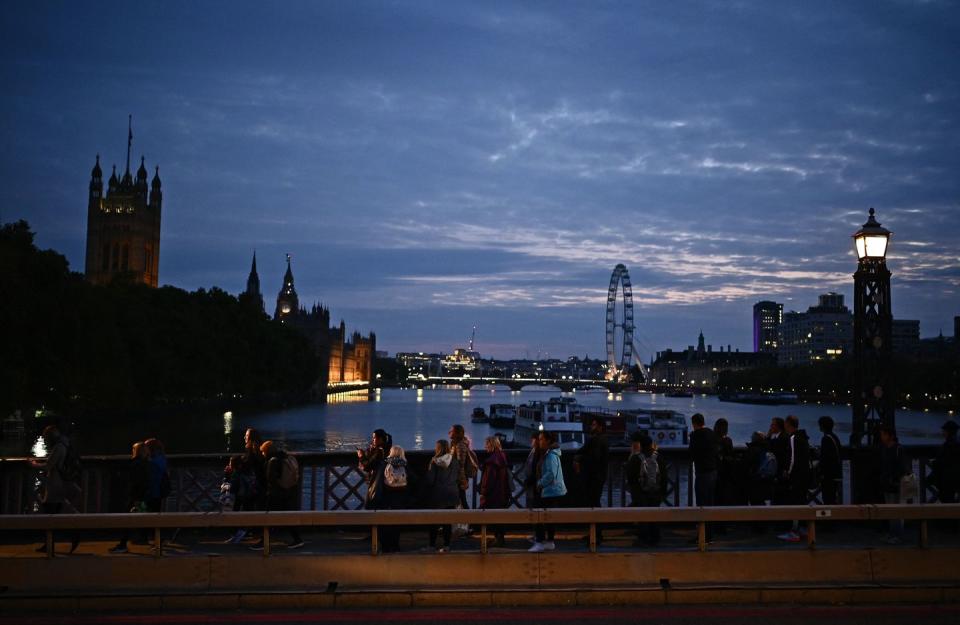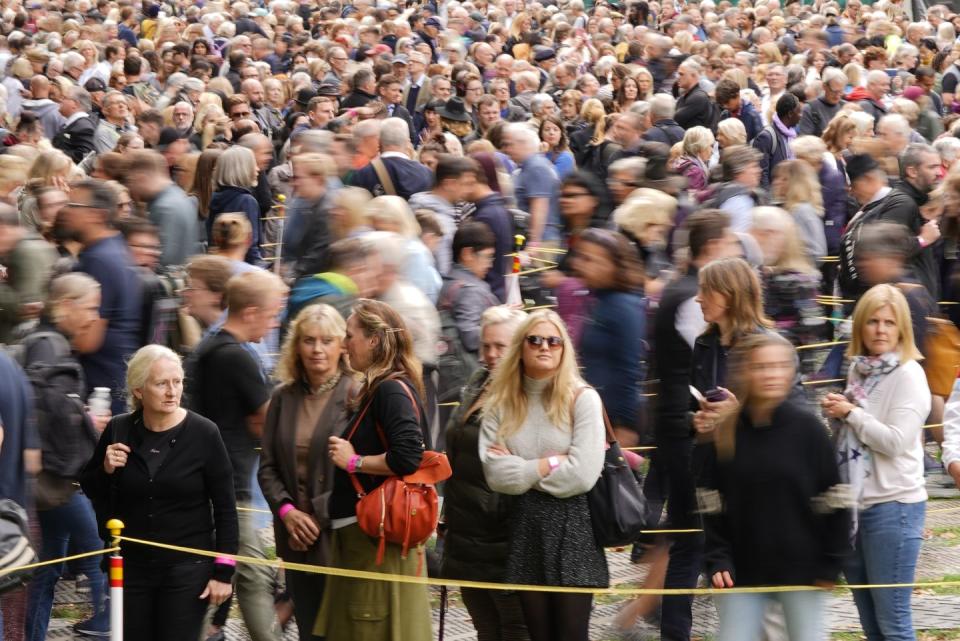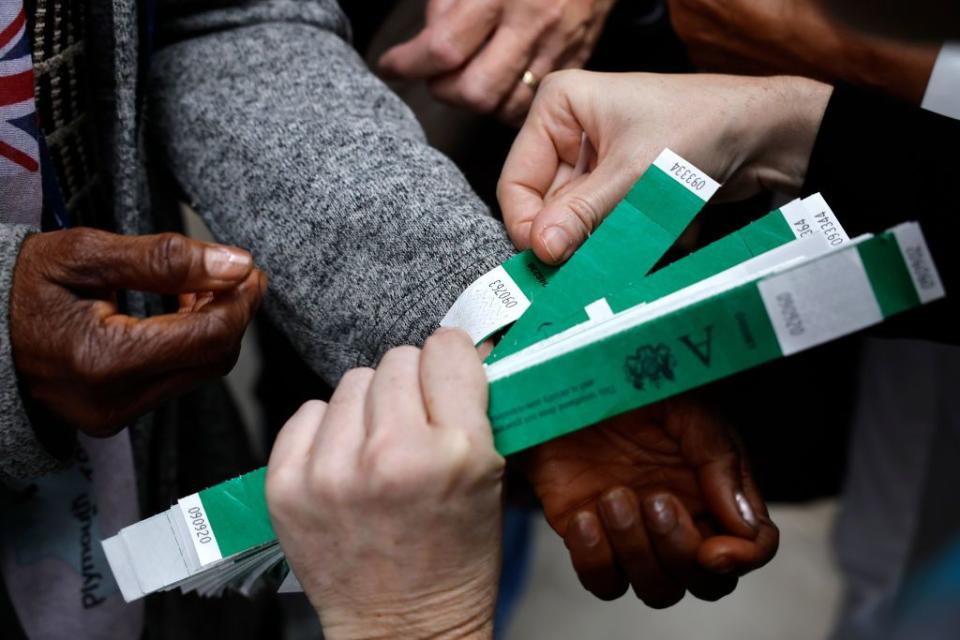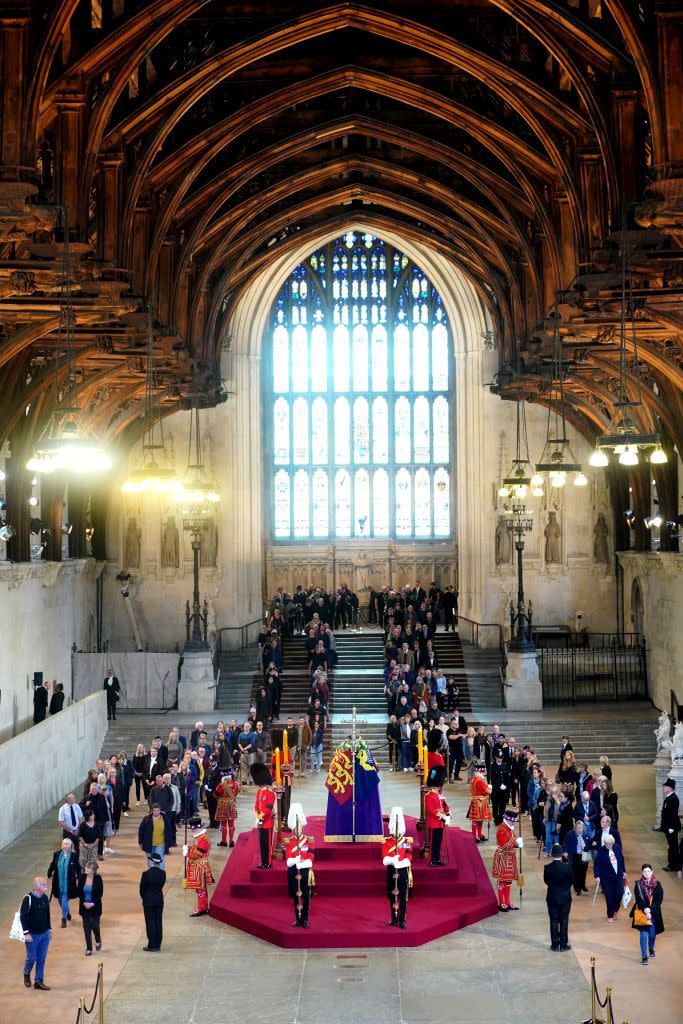Why I Waited 20 Hours in Line to See the Queen's Coffin
Even in mourning, Brits love a queue.
The wait to pay tribute to Queen Elizabeth’s coffin winds along the Thames River for roughly five miles of shoulder-to-shoulder British subjects in constant procession, twenty-four hours a day, from yesterday to Monday morning, just hours before the Queen’s funeral.
I arrived twenty hours before the line officially started moving and was one of the first people through. (My number on color-coded wristband—the first 2000 mourners in line received a gold band—was #109.)

There were, of course, tedious logistics involved. As a friend put it, “You’re essentially camping out for a funeral, and I already don’t like camping.” But the bathroom breaks and food or drink questions had ordinary answers (portable toilets and snack or coffee kiosks). Although in this extraordinary circumstance, even that can take a turn, as when a delivery of four pizzas went to the nearest physical residence: Lambeth Palace, home of the Archbishop of Canterbury. Or the presence of a truck with “SWAT” painted on the side (in this case, for Sikh Welfare Awareness Team), from which Sikhs handed waiting mourners free coffees, teas, soups, hot chocolates, and candy bars in the name of nishkam, which translates to “selflessness.”
More intangible were the emotional logistics—the promise of pomp tempered by the sting of grief, as condolence blurred with excitement at a once-in-a-lifetime experience, like a bucket-list visit to the Pyramids at Giza, Terracotta Army, or Taj Mahal (all tombs).
There’s a mystical allure to the British royal family. “I’ve met the Norwegian royals and they don’t have the pomp,” said Neil Wright, 58, a gas services engineer from Kidderminster, outside Birmingham, who viewed the coffin in Edinburgh but wanted to have the experience on English soil.

So much of the experience of this queue depends on the people you share it with, and I like so many others turned up alone only to find deep fellowship whilst waiting. I will be forever grateful to Melissa Di Roma, 34, a cafe manager from Brighton whose love for the Queen spurred her immigration from Italy; Angela Johnson, 52, a parole officer from Southport who used her characteristic order-muppet mojo to help us find an emotional fit for the moment; John Bradley, 63, a retired supply-chain manager from Porthmadog in North Wales, who transcended fatherly qualities to be a true partner as the waiting grew melancholy; and Marie Burnett-Hockey, 54, a mother from Gloucestershire. We piggybacked on the stitched-up guidance and comfort she offered her twin 14-year-old sons.
Some people channeled their sadness through fastidiousness, such as John Stokes, 48, an electrical and mechanical engineer from Wolverhampton whom we called Bowlerman for his get-up, which made him look like an extra in The King’s Speech. Many men, in fact, wore the best clothes they had, including a man who wore the suit he got married in thirty years ago in Scotland, plaid lapels and all. Surprised by the Queen’s death while on vacation (I’m a British subject who lives in the U.S.), I wore the best I had: head-to-toe Old Navy with Converse shoes.
There was of course the ants-at-a-picnic presence of press, but their fleeting, distracting needs only served to amplify, as a spiritual foil, a sense of purpose and presence.
The mourning path runs along the National Covid Memorial Wall, a throng of painted hearts upon which visitors are invited to write the names of loved ones. It evoked an echo from the Queen herself, who mourned the loss of her husband while masked and sitting alone in pews, and who addressed the nation with a promise that, “We will meet again.” Many mourners now find themselves in this one last meeting, offered by the Queen even in death.

Meandering through the Victoria Tower Gardens outside of Westminster Palace, our disorientation was comforted by the proud postures of child Scouts—as in Boy Scouts and Girl Scouts—who stood sentry along the path. Or adult guides—stationed throughout the garden to prep— like the cherubic Alice Pooley, who tearfully described receiving a thank-you note from the Queen just last month after sending homemade Jubilee bunting to Buckingham Palace this summer.
To hear the bells at Westminster Abbey and proceed along a winding cobblestone path felt a bit like the final stretch of the Yellow Brick Road; indeed, the four of us — Angela, John, Melissa, and me — locked arms as we walked.
It seems crass to detail the event’s airport-style security clearance except to note the intense requirement that all phones be powered off, not merely silenced.
In life, entering a room with the Queen was known as experiencing the Presence. So it was in death, too. Her coffin, raised on a catafalque in tiny might and swaddled in the royal banner, commanded focus even in the ornate, cavernous chamber of Westminster Hall.
Seeing it all—the heraldry, the candles, the costumes, the Imperial state crown and Beefeater guards alongside a rotation of vigilant sentinels including the Gentlemen at Arms, the Royal Company of Archers, and the Yeomen of the Guard—was, to me at least, an overwhelming flurry of symbolism, heritage, and history, like taking in a foreign-language opera and hoping the music alone can shepherd you through your ignorance of the words.

Every twenty minutes in the twenty-four-hour vigil around the coffin, there is a changing of the guards. Because the viewing began at 5:00 p.m. on Wednesday and I entered shortly afterwards, I witnessed the first such hand-off.
The procession stopped. (Nobody said “Stop!” of course; guards merely held up their hands and said a discreet, “Thank you.”) Suddenly two booming thumps thundered through the hall as a guard on a raised set of stairs banged something against stone. Amid all the ornamentation, this organized banging seemed almost tribal.
The new guards solemnly filed in, step by step in clunky metallic boots, and I realized what was happening. Here I had come looking to decipher the event’s meaning and, instead, fate spoon-fed me wisdom: You never have as much time as you think with anyplace, anything or anyone—not even with a guard at a lying-in-state procession. Even a moment days in the making, days in the pondering, and days in the feeling, can upend expectations and require fresh, raw, unrehearsed response. Every heart should make peace not with its moods, but rather with the permanent and absolute amateurism that comes with feeling your way through the nascence of what’s next.
What was next for me was the moment that was the reward for twenty hours of tired patience.
I have never been married and so can’t speak from personal experience of walking down any aisle outside an airplane or a theater, but the three or four steps I took before turning to bow at the coffin felt like a lifetime’s worth of duty.
After my few allotted moments I stood and proceeded out of the hall, but in many ways I am still bowing. It was a bow that tilted both my spine and my soul.
I walked through the open doors into the streets of central London so full of fresh air and fresh tears, coldness and warmth, the way stillness can be moving and silence can be loud.
“There’s that done,” I said to myself as I pulled my folded bucket hat out of my pocket and put it back on. But it was a lie. The moment could not be done and would never be done. I had been too undone by it.
You Might Also Like

